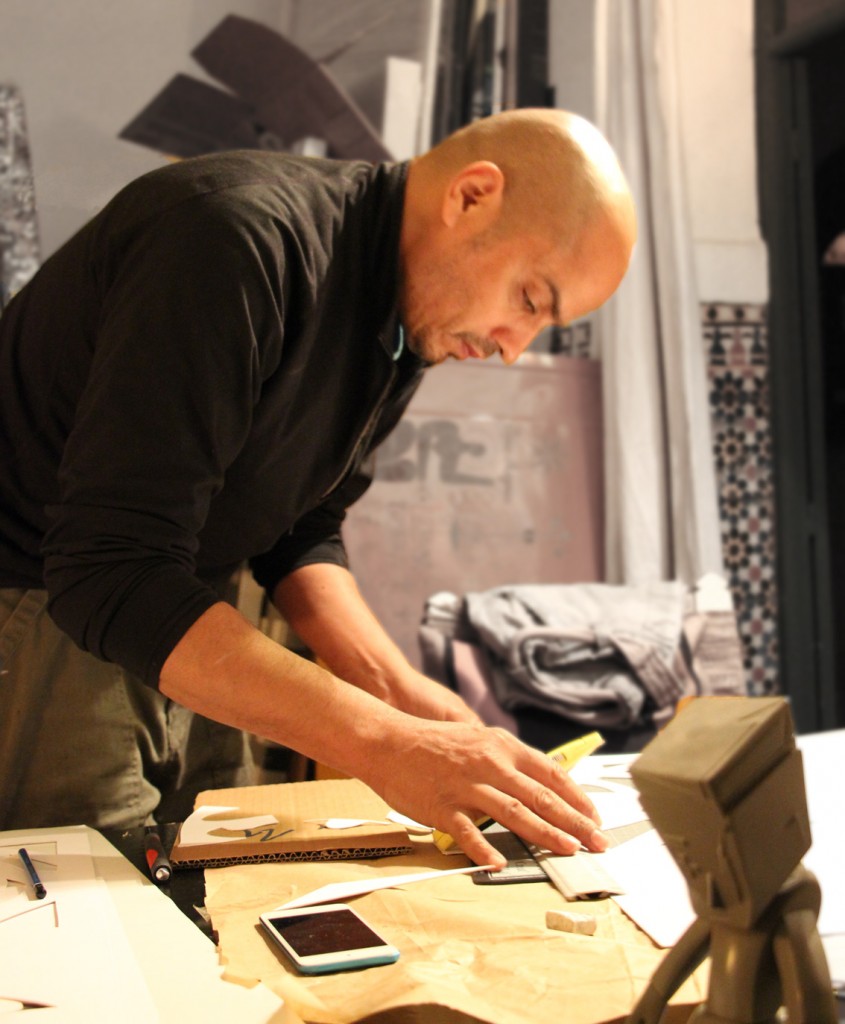Legendary Carlos Mare and Vincent Abadie Hafez AKA Zepha opened their 2 person collaborative exhibition last night at David Bloch Gallery in Morocco. The exhibition titled “The intersection of Memories” is a must see and we will have a full recap and show summary when we get the installation photos.
GF
Crossing Paths – The Intersection of Memories
The David Bloch Gallery is pleased to host a new exhibition bringing together two of its resident artists : Carlos Mare et Vincent Abadie Hafez. Entitled “Crossing paths – The Intersection of Memories”, this duo show is driven by the artists common passion for writing, as a meeting place between graffiti and traditional islamic art.
Polymorphic, this exhibition consists of works on canvas, works on paper and sculptures made of various materials, completed individually or in duo. The openning is to take place on December 18th, in the presence of the artists.
Vincent Abadie Hafez and Carlos Mare are two artists firmly grounded in their graffiti culture yet freed from its codes. Bound together by their street culture and search for abstraction, they also share a deep interest for cultural crossbreeding and a common inspiration for islamic patterns and designs. The two cross paths in Marrakesh in May 2013, while Carlos Mare, on his first visit to Morocco, is exhibited within the Group Show “Unfolding” featuring the AOC collective (Agent of Change). Iconic figure of the graffiti movement in the mid 1970s, Carlos Mare discovers Vincent Abadie Hafez painting, reinterpreting Arabic calligraphy and graffiti so as to fuse them. This hybrid approach makes particularly sense for the New York artist, who always sought to pull the art of graffiti towards new expressions, notably through sculptures.
Their artistic collaboration initiates, based on their passion for the letter – written, deconstructed and revisited in the light of Moroccan islamic arts and crafts. Matured over two years, this association takes shape this year in a creative residency in Marrakesh, during which the two artists conduct a dialogue between their respective language and universe, in search for new expressions, at the crossroad of art, culture and geography. This residency provides Carlos Mare with the opportunity of working with craftsmen of the medina, with which Vincent Abadie Hafez is already familiar, as a result of his many projects in Morocco, notably his two solo shows at the David Bloch Gallery or his recent participation within the “Jidar” mural Festival, last May. Together, and in contact with the Marrakchis woodworkers, coppersmiths and metalworkers, the two artists give birth to strong and unprecedented artworks, conveying a quest for hybrid sense and aesthetics, between calligraphy, graffiti and abstraction.
Born in 1965, Carlos Mare is a Puerto Rican American Urban Modernist sculptor, painter and major artist of the contemporary urban arts movement of which he is also a renowned Theorist and Educator. Originally from New York, more precisely from the Spanish Harlem and South Bronx district, Carlos Mare is one of the greats of the Metro Graffiti golden age (1976-1986). He gained international recognition in the important 1982 Hip Hop documentary “Style Wars” by the name of Mare139. Writing alongside the most influential pioneers and Style Masters of the movement, like his brother Kel First, Dondi White, Crash, and Kase2, he was primed to master the art for the following generations. From 1980 onward his articulation of the art and culture began to take form when he was exposed to Picasso and the modernists prompting his interest in ‘relevance by proximity’, he then focuses his personal studies on art history in order to defend and advance Graffiti culture and by 1985 Mare distinguishes himself by pulling graffiti to a new dimension: metal sculpture and by directly infusing Modernist theory and aesthetic into his work. Inspired by the forward-thinking artists of the European Avant Guarde, Cubist, Futurists and Constructivist, his metal sculptures over the years reflect the correlations between these periods and graffiti but owns the time of which it is from. Carlos Mare sculptures highlight the kinetic energy of graffiti writing in physical space and the reappropriation of this space with big metal volumes and absent volumes of light and shadow, he activates architectural space with these structural interventions with great deft and confidence . For over thirty years he has continued to revise its codes and aesthetics. His work in the 2013 Unfolding exhibition at David Bloch reveals his interest in Islamic architecture and motifs whereby the work was informed by the location. A member of the collective Agents of Change, Mare has been honored by Pera Museum (2014) Language of the Wall, the MOCA of Los Angeles on the occasion of the major exhibition « Art in the streets » (2010) and has been shown in other galleries and Museums worldwide. He is also US State Department Cultural Ambassador for Urban Arts, Hip Hop Scholar, active Lecturer, and advocate for the Arts.
Born in 1977, Vincent Abadie Hafez is a French artist whose cosmopolitan work stands at the confluences of various arts : handicraft workmanship inherited from ancient civilisations, the ” Figuration libre” movement, “Lyric Abstraction” and Street Art. Like Carlos Mare, Vincent Abadie Hafez firstly involved in Graffiti, as soon as 1989, under the moniker of Zepha, before developing an hyvrid visual universe, at the crossroads of times and cultures.
Mixing mediums, techniques and influences, the artist gives life to striking compositions marked with mysterious harmony and graphic power. Showing a right balance between thoughtful composition and instinctive strokes, he draws his inspiration from Eastern and graffiti calligraphy so as to reveal traces, signs and motifs which have less to do with writting than with construction, rhythm and symbol. Playing on proportions, downstrokes and upstrokes, his compositions resonate with oddly familiar references and a new unexplored language. Contrasts, oppositions and complementarities emphasize the energy stemming from his artworks, which look tested by time, bearers of memory, and vector of the artist questioning on a world menaced by oblivion regarding the very principles of its existence.











